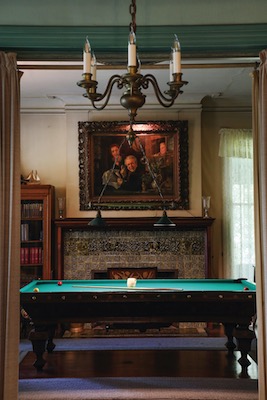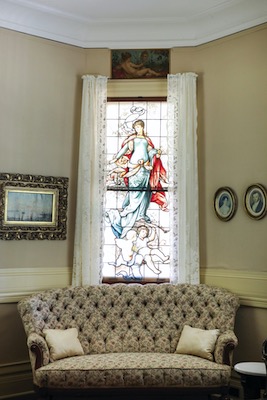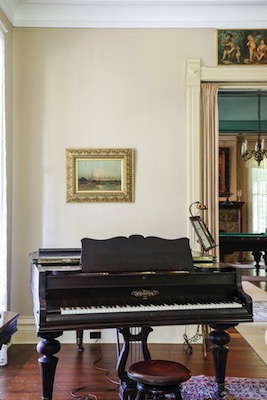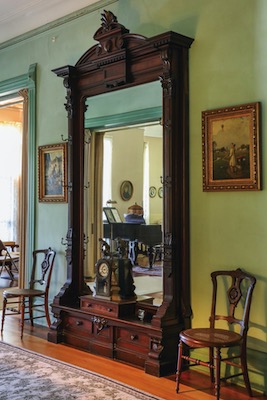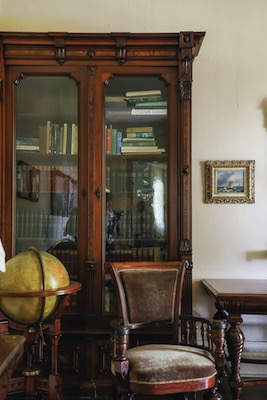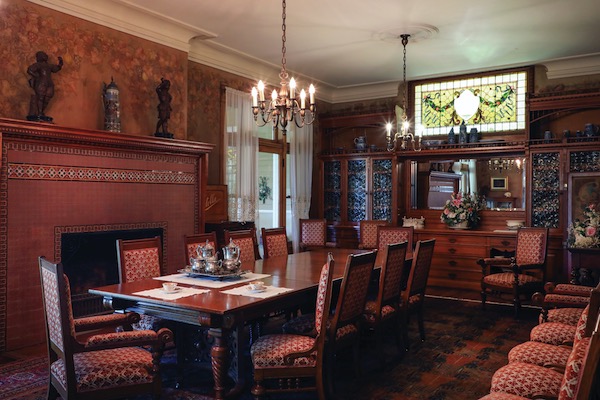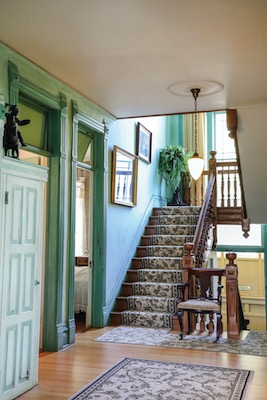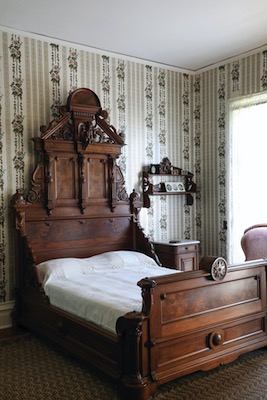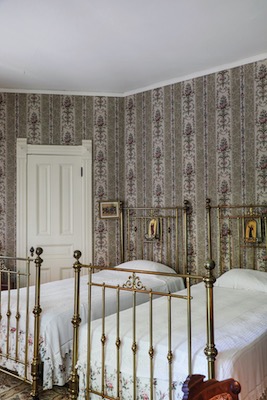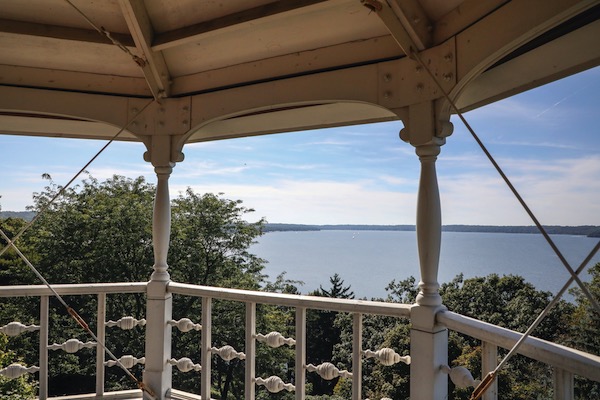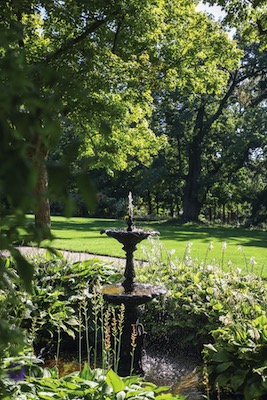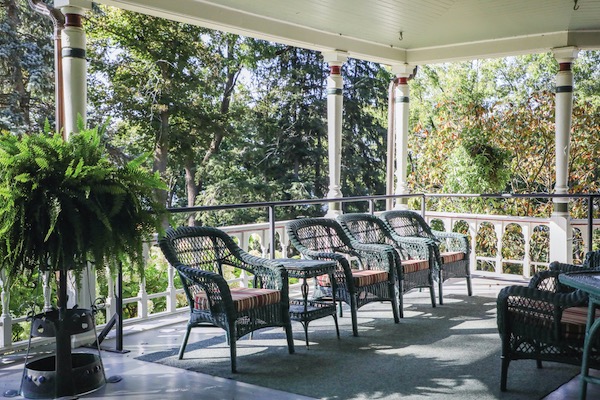By John Halverson | Photography by Shanna Wolf
“Our story is really more about the passing of time as experienced by one family in one location for more than 117 years,” says David Desimone, site director of Black Point Estate & Gardens.
Yet the mansion on the south shore of Geneva Lake, which has drawn tens of thousands of visitors, puts things in perspective. Reminders of past eras are scattered throughout — eras of great transitions and the overcoming of great challenges.
Black Point was built as a summer home by Conrad Seipp, a Chicago beer baron. It’s become one of the most attractive tourist destinations in the Geneva Lakes area. (Although this year, its opening date was delayed due to COVID-19.)
Most historical sites, similar to Black Point, are stuck in time. Historians, like Desimone, call these “periods of significance.” But Black Point is unusual in that it represents generations. While it can be appreciated for its architecture and its grandeur and its grand view of Geneva Lake, it also shows how life was lived from one year to the next and how the events that shaped the Seipp family and the world made their mark on it.
IF THESE WALLS COULD TALK
Black Point was an active home before automobiles and electricity, through depressions and two World Wars, to John F. Kennedy’s assassination, to Watergate, to 9-11 and beyond. And it’s still here — a constant — in an everchanging world, with memories and a place in history that will outlive us all.
The objects in the house are as varied as the eras and the family members who called Black Point home. According to Desimone, the property includes books from the 1870s, “On the Road” by Jack Kerouac from the 1950s and the 1993 novel “Girl Interrupted.”
There is furniture and other household items from the 1860s to the 1920s and beyond, including brass bed frames that became popular after the 1918 influenza pandemic — because they could be more easily cleaned than wood — and a 1970s green shag rug.
There is clothing left behind from the 1900s, including a Victorian dress, a cocktail dress from the early 1950s, 1930’s German lederhosen and a 1990’s baseball cap.
There are toys — a collection from the 1870s comprised of a dollhouse, wooden dolls, wagons and animals, a 1930’s Monopoly board, even coloring books from the 1960s. You’ll also find linens from the 1890s, embroidery samplers, 1910 pillowcases and 1940’s napkins.
On a personal tour for At the Lake, Desimone stopped at a closet and pulled out a magazine from 1996.
“Someone just threw it in here, figuring ‘I’ll finish it later,’” Desimone says. “I’m probably the first guy to move it since then.” On the shelf above, he noted a photo of Abe Lincoln from the mid-1860s.
Then there’s an entire bookshelf, with common things spanning more than 100 years, all sharing the same family provenance.
AN ACTIVE SUMMER “COTTAGE”
“It doesn’t feel like a showcase,” Desimone says of Black Point. “It feels more like my grandmother’s house. People don’t want to see more decorated bedrooms. They want to peek behind the curtain and see how people lived.”
The mansion was a playful place, where Seipp children played hide and seek in the home’s many nooks and crannies and slid down the roof.Therewasevena12-foot-longdragon on the property made with plaster of Paris.
“And on a rainy Tuesday when they couldn’t go swimming, they’d open the closets and play dress-up,” Desimone says.
Every bedroom led to the balcony, he explains. The child most likely to be the most mischievous was placed next to grandma’s room, where she’d surely notice any culprit wanting to make a quick escape.
The 20-room Queen Anne-style “cottage,” designed by architect Adolph Cudell, was completed in 1888 for $20,000. That’s about a half million dollars in today’s money. Still, it was a pittance compared to the cost of one of Seipp’s Chicago mansions, which had a price tag of $250,000 — $6 million now.
The estate included 13 bedrooms and only one bathroom. Since then, makeshift bathrooms were added in closets throughout the house.
“In the Victorian era women might only take one bath a week,” Desimone says. “Us hardy guys would go down to the lake with a bar of soap.”
The term “cottage” seems like a misnomer, but it fit the definition of a summer residence that was not used year-round. In fact, the estate is still not fit for year-round occupancy. In the off-season, furniture and artwork are draped in sheets as protection against the cold.
Unfortunately, Seipp was able to enjoy the house and gardens for only two seasons before his death in 1890.
FROM ÉMIGRÉ TO WEALTHY BEER BARON
Seipp outlived many challenges in his own life, first escaping from Germany during a tumultuous time, when revolution in Europe was at a high point. Born in 1825, Seipp emigrated to the United States in 1849. Soon after, he was married and moved to the Chicago area, where he landed a job driving a beer wagon.
He saved enough to buy a brewery but within a year it burned to the ground. Unwavering, Seipp built a new brewery, this time constructed of brick. It flourished; then his wife of 18 years died. He married another German émigré (Catharina) within a year.
Much of Chicago burned in the fire of 1871. Seipp was lucky because his brewery was far enough out of the city to avoid the blaze that devastated so many. Seipp took a benevolent stance.
In “Black Point Legacy” by Anne Celano Frohna, Seipp states, “There were lots of people ruined at that time.” He goes on to say, “I always think when I see a poor fellow in the street, if he has to all appearances [been] an honest man, maybe somebody has made money out of his misfortune. And if he chances to come to me, I can’t turn him away.”
Along the way, Seipp became one of Chicago’s richest men and built a grandiose home in the city, but he longed for a house “where I could see the bright green lake, instead of a palace where I can see nothing.”
Those longings led him to Geneva Lake, then a burgeoning spot for the Chicago elite, a jaunt made easier by a train connection to the small town of Lake Geneva. At first, he and his family visited Kaye’s Park Resort on Geneva Lake but eventually made a home on an adjacent property — a place that became known as Black Point.
A GENEROUS GIFT BRINGS YEARS OF DEBATE
Bill and Jane Petersen were the last family members to own the estate. “They wanted to make sure it existed long after they were gone and not sold to a developer and destroyed and the land subdivided,” Desimone explains. “They worked for more than 10 years to make that dream a reality, ultimately donating the property to the state of Wisconsin in 2005 so that it could be used as a museum.”
You’d think a donation of such a historic mansion would be welcome. But residents around the lake fought the Petersens with legal actions.
They worried that the property wouldn’t be maintained and that tourists would overrun the neighborhood, and they feared property values would go down. Those fears didn’t come to fruition.
The agreement limited the number of people who visit the estate at one time and meant that almost all arrived by the Lake Geneva Cruise Line or bus.
Would the transaction not have occurred if an agreement hadn’t been reached with the Cruise Line? “Probably not,” Desimone says. “As everyone knows around Geneva Lake, the Cruise Line is a top flight operation and while it does make a visit to Black Point one of the more expensive historic house tickets, the experience of the cruise and the house tour are truly unique, and in many ways helps us separate ourselves from the more than 10,000 other historic houses in the United States.”
The estate is listed on the National Register of Historic Places. It gained that status because the building was deemed architecturally significant and mostly unaltered and original. It’s been named among the 10-best home-estate tours in the United States by Fodor’s Travel alongside Biltmore Estate, Mount Vernon and Monticello.
There have been changes, including a new roof, a restored exterior paint scheme, upgraded utilities, fire detection and security systems, and a rebuilt veranda. The hardwood floors on the first floor have also been restored. The estate has added a woodland garden and planted more than 1,200 plants on the hillside to help with soil erosion.
While improvements are done as needed, the home is kept as authentic as possible — visitors still want to see the estate as it was.
Attendance has varied between 2,500 and 10,000, with mostly steady growth since 2013 when the Wisconsin Historical Society took over. Those numbers are buoyed somewhat by an outreach program which brings the Black Point experience to others at nursing homes and libraries.
“We moved from tourist attraction to historical community resource,” says Desimone. “In other words, we needed to bring the programming to the community and not just wait for people to come and visit.”
Special events have been added, including beer tastings, a “Beer and Brats with Conrad” featuring a Conrad Seipp impersonator, and a Victorian funeral program. This broadens the appeal to those who have already visited.
The annual budget for Black Point is roughly $300,000. “The economic impact is far more significant than that,” says Desimone. While Black Point doesn’t measure the exact impact on the local economy, the American Association of Museums uses a formula that would put it close to $1 million annually.
Little did Conrad Seipp know that the cottage on the lake that he built so long ago would survive through so much history and still be available to so many today.
Editor’s Note: Black Point Estate & Gardens opened to the public for the 2020 season on July 1. Due to the fluid nature of the COVID-19 pandemic, please call the site at 262-248-1888 for the latest information regarding tours.


